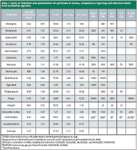Quick Start-Up for a Modified QuEChERS Multi-residue Pesticide Analysis in Lettuce by GC–MSn
The Application Notebook
Use of a modified QuEChERS sample preparation procedure was fully evaluated for identification and quantitation of pesticides in lettuce using gas chromatography and ion trap mass spectrometry. Final results compared favorably to the reporting and detection limits offered by several worldwide agencies, demonstrating a robust and reliable solution for analyzing pesticide residues in lettuce.
David Steiniger, Jessie Butler, and Eric Phillips, Thermo Fisher Scientific
Use of a modified QuEChERS sample preparation procedure was fully evaluated for identification and quantitation of pesticides in lettuce using gas chromatography and ion trap mass spectrometry. Final results compared favorably to the reporting and detection limits offered by several worldwide agencies, demonstrating a robust and reliable solution for analyzing pesticide residues in lettuce.
Many newer pesticides are smaller in molecular weight and are designed to break down rapidly in the environment. Sample preparation and instrument analytical parameters must be carefully considered to address the analytical challenge these pesticides represent. A dispersive solid phase extraction (d-SPE) technique called QuEChERS (Quick, Easy, Cheap, Effective, Rugged, and Safe), published recently as AOAC Method 2007.01, simplifies sample preparation for pesticide residue analyses (1). For this study, linear range and limits of detection and quantitation for a list of pesticides commonly used on iceberg lettuce crops were determined using samples prepared according to a modified QuEChERS method, followed by detection and quantitation on the Thermo Scientific ITQ 700™ GC-ion trap mass spectrometer. Method accuracy and precision were evaluated by analyzing multiple matrix spikes at 50 ng/g and at 5 ng/g. The results compared favorably to reporting and detection limits offered by several worldwide agencies, demonstrating that a modified QuEChERS method followed by GC–MSn offers a robust and reliable solution for analyzing pesticide residues in lettuce.
Experimental Conditions
All samples and standards were prepared in matrix for generation of the calibration curve, detection limit and method validation studies. Sample prep followed a modified QuEChERS procedure, which entailed extraction, cleanup, plus a solvent exchange step to provide a final extract more amenable to splitless injection. The samples were analyzed on a split/splitless injector using a surge splitless injection, which minimizes band broadening, provides narrow GC peaks, and limits residence time in the injection port for reduced breakdown and activity. Liner activity was evaluated daily using endrin and endrin breakdown products to ensure system suitability. A constant column flow of 1 mL/min ensured good chromatographic separation, and a Thermo Scientific TRACE™ TR-527 (0.25 mm × 30 m, 0.25 μm) was used as the analytical column (3).
Detection was performed using the ITQ 700 ion trap mass spectrometer in MSn mode. Precursor ions and product ions were selected for the pesticides and collision energies were optimized to ensure optimal product ion production (3). Because of the elimination of matrix interferences, MSn produces more accurate and precise results at low levels, which enables lower limits of detection and quantitation. Confidence in the presence of a given pesticide is also improved since detecting product ions as fragments of a specific precursor ion is more selective and less prone to interference.
Results
A calibration curve across five levels (1 ng/g to 50 ng/g) was generated in lettuce matrix. Linearity across this range was R2 > 0.99 for most compounds. Internal standard and surrogate precision were 6 and 7% relative standard deviation (RSD) respectively. Limits of detection (LOD) and quantitation (LOQ) were determined by preparing matrix spikes at 5 ng/g. Eight matrix samples spiked at this concentration were analyzed, and the LOD and LOQ were calculated by multiplying the standard deviations of the calculated amounts for each pesticide by three and ten respectively. Recoveries ranged from 87–126%, with an average of 105%. Method validations were performed on four matrix samples spiked at a concentration of 50 ng/g. These samples showed an average recovery of 93% and an average 9.7% RSD. Comprehensive results for method detection and quantitation limits compared to international reporting limits (MRLs) are shown in Table I.

Table I: Limits of detection and quantitation for pesticides in lettuce, compared to reporting and detection limits from worldwide agencies
Conclusions
The Thermo Scientific ITQ 700 GC-ion trap MS was thoroughly evaluated and showed excellent accuracy at low concentrations for a number of pesticide residues analyzed in iceberg lettuce. Calibration curves for the pesticides studied had excellent linearity, with correlation coefficients of R2 > 0.99 for most compounds. The method validation study generated an average % RSD of 9.7% for four replicate analyses at 50 ng/g, and a calculated average LOD of 2.7 ng/g in iceberg lettuce was achieved based on eight replicate analyses of 5 ng/g. The modified QuEChERS method followed by GC–MSn provides a powerful tool for analyzing pesticide residues in lettuce.
References
(1) Lehotay, S. AOAC Official Method 2007.01 "Pesticide Residues in Foods by Acetonitrile Extraction and Partitioning with Magnesium Sulfate." Journal of AOAC International, 90 (2), (2007) 485–520.
(2) Okihashi, M. "Rapid Method for the Determination of 180 Pesticide Residues in Foods by Gas Chromatography/Mass Spectrometry and Flame Photometric Detection." Journal Pesticide Science, 304 (4), (2005) 368–377.
(3) Steiniger, D., Butler, J., Phillips, E. "Quick Start-Up for a Modified QuEChERS Multi-residue Pesticide Analysis in Lettuce by GC/MSn ." Thermo Fisher Scientific Inc. Technical Note TN10236. www.thermo.com/gcfoodsafety.

Thermo Fisher Scientific, Inc.
2215 Grand Avenue Parkway, Austin, TX 78728
tel. +1 800-532-4752; fax +1 561-688-8731
Email: analyze@thermo.com

Separation of Ultra-Short and Long Chain PFAS Compounds Using a Positive Charge Surface Column
December 11th 2024A separation of ultra-short and long chain PFAS (C1-C18) is performed on a HALO®PCS Phenyl-Hexyl column along with a HALO®PFAS Delay column which demonstrates excellent retention for both hydrophilic and hydrophobic analytes.

.png&w=3840&q=75)

.png&w=3840&q=75)



.png&w=3840&q=75)



.png&w=3840&q=75)














